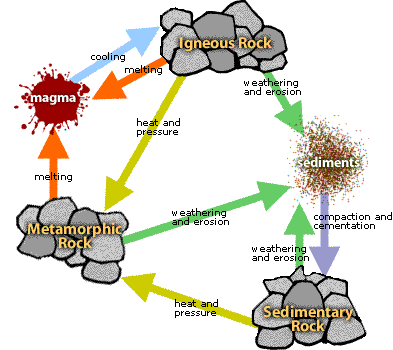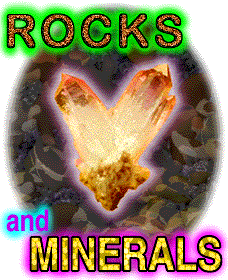| The Rock Cycle is a group of
changes. Igneous rock can change into sedimentary rock or into
metamorphic rock. Sedimentary rock can change into metamorphic
rock or into igneous rock. Metamorphic rock can change into
igneous or sedimentary rock.
Igneous rock forms when
magma cools and makes crystals. Magma is a hot liquid made of
melted minerals. The minerals can form crystals when they cool.
Igneous rock can form underground, where the magma cools slowly.
Or, igneous rock can form above ground, where the magma cools
quickly.

When it pours out on
Earth's surface, magma is called lava. Yes, the same liquid rock
matter that you see coming out of volcanoes.
On Earth's surface, wind
and water can break rock into pieces. They can also carry rock
pieces to another place. Usually, the rock pieces, called
sediments, drop from the wind or water to make a layer. The layer
can be buried under other layers of sediments. After a long time
the sediments can be cemented together to make sedimentary rock.
In this way, igneous rock can become sedimentary rock.
All rock can be heated. But
where does the heat come from? Inside Earth there is heat from
pressure (push your hands together very hard and feel the heat).
There is heat from friction (rub your hands together and feel the
heat). There is also heat from radioactive decay (the process that
gives us nuclear power plants that make electricity).
So, what does the heat do
to the rock? It bakes the rock.
Baked rock does not melt,
but it does change. It forms crystals. If it has crystals already,
it forms larger crystals. Because this rock changes, it is called
metamorphic. Remember that a caterpillar changes to become a
butterfly. That change is called metamorphosis. Metamorphosis can
occur in rock when they are heated to 300 to 700 degrees Celsius.
When Earth's tectonic
plates move around, they produce heat. When they collide, they
build mountains and metamorphose (met-ah-MORE-foes) the rock.
The rock cycle continues.
Mountains made of metamorphic rocks can be broken up and washed
away by streams. New sediments from these mountains can make new
sedimentary rock.
The rock cycle never stops.
|






